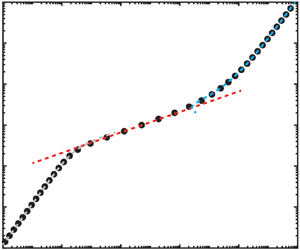Crossref Citations
This article has been cited by the following publications. This list is generated based on data provided by
Crossref.
Boyko, Evgeniy
and
Stone, Howard A.
2021.
Reciprocal theorem for calculating the flow rate–pressure drop relation for complex fluids in narrow geometries.
Physical Review Fluids,
Vol. 6,
Issue. 8,
Wang, Yanwei
2022.
Steady isothermal flow of a Carreau–Yasuda model fluid in a straight circular tube.
Journal of Non-Newtonian Fluid Mechanics,
Vol. 310,
Issue. ,
p.
104937.
Christov, Ivan C
2022.
Soft hydraulics: from Newtonian to complex fluid flows through compliant conduits.
Journal of Physics: Condensed Matter,
Vol. 34,
Issue. 6,
p.
063001.
Zhong, Xiaoxu
Mitra, Harsa
Veilleux, Jean-Christophe
Simmons, Emma
Shi, Galen Huaiqiu
and
Ardekani, Arezoo M.
2022.
The role of liquid rheological properties on the injection process of a spring-driven autoinjector.
International Journal of Pharmaceutics,
Vol. 628,
Issue. ,
p.
122296.
Chun, SungGyu
Ji, Bingqiang
Yang, Zhengyu
Malik, Vinit Kumar
and
Feng, Jie
2022.
Experimental observation of a confined bubble moving in shear-thinning fluids.
Journal of Fluid Mechanics,
Vol. 953,
Issue. ,
Roshchin, Dmitrii
Kravchenko, Igor
Fu, Taotao
and
Patlazhan, Stanislav
2023.
Effect of flow bifurcation transitions of shear-thinning fluids on hydrodynamic resistance of channels with sudden contraction and expansion.
Chemical Engineering Science,
Vol. 281,
Issue. ,
p.
119169.
Kozak, Yoram
2023.
Close-contact melting of phase change materials with a non-Newtonian power-law fluid liquid phase—Modeling and analysis.
Journal of Non-Newtonian Fluid Mechanics,
Vol. 318,
Issue. ,
p.
105062.
Kim, Dongwoo
An, Sehyeon
and
Yeom, Eunseop
2023.
Investigation of cell performance in pin geometry of solid oxide fuel cell considering blower power input.
Chemical Engineering Science,
Vol. 282,
Issue. ,
p.
119350.
Baños, R.
Arcos, J.
Bautista, O.
Méndez, F.
and
Martínez-Suástegui, L.
2023.
Oscillatory Marangoni flow in a deep layer of a Carreau fluid.
Physics of Fluids,
Vol. 35,
Issue. 4,
Hu, Nan
and
Fan, Li-Wu
2023.
Close-contact melting of shear-thinning fluids.
Journal of Fluid Mechanics,
Vol. 968,
Issue. ,
Anand, Vishal
and
Narsimhan, Vivek
2023.
Dynamics of spheroids in pressure-driven flows of shear thinning fluids.
Physical Review Fluids,
Vol. 8,
Issue. 11,
Chun, SungGyu
Boyko, Evgeniy
Christov, Ivan C.
and
Feng, Jie
2024.
Flow rate–pressure drop relations for shear-thinning fluids in deformable configurations: Theory and experiments.
Physical Review Fluids,
Vol. 9,
Issue. 4,
Barmak, Ilya
Picchi, Davide
Gelfgat, Alexander
and
Brauner, Neima
2024.
Flow of a shear-thinning fluid in a rectangular duct.
Physical Review Fluids,
Vol. 9,
Issue. 2,
Shreekrishna, Suhas
Mandal, Shubhadeep
and
Das, Sayan
2024.
Spontaneous emergence of motion of an isotropic active particle in a Carreau fluid.
Soft Matter,
Vol. 20,
Issue. 48,
p.
9683.
Oliveira, Paulo J.
2024.
A shear and elongational decomposition approach of the rate-of-deformation tensor for non-Newtonian flows with mixed kinematics.
Journal of Fluid Mechanics,
Vol. 1001,
Issue. ,
Steinik, Camille
Picchi, Davide
Lavalle, Gianluca
and
Poesio, Pietro
2024.
Capillary imbibition of shear-thinning fluids: From Lucas-Washburn to oscillatory regimes.
Physical Review Fluids,
Vol. 9,
Issue. 2,
Kumar, Rakesh
Ghosh, Amritendu Bhuson
Borah, Bidisha
Lakkaraju, Rajaram
and
Atta, Arnab
2024.
Exploring fluid flow in microchannels with branching and variable constrictions.
Microfluidics and Nanofluidics,
Vol. 28,
Issue. 11,
Báez-Amador, J.
Baños, R.
Arcos, J.
Méndez, F.
and
Bautista, O.
2024.
Flow enhancement produced by a pulsatile flow of shear-thinning fluids in circular and concentric annular tubes.
Journal of Non-Newtonian Fluid Mechanics,
Vol. 334,
Issue. ,
p.
105346.
Chhabra, R.P.
and
Patel, Swati A.
2025.
Non-Newtonian Flow and Applied Rheology.
p.
121.
Residori, Mirko
Mandal, Suvendu
Voigt, Axel
and
Kurzthaler, Christina
2025.
Flow through porous media at the percolation transition.
Physical Review Research,
Vol. 7,
Issue. 1,




